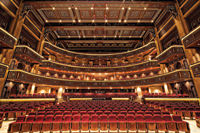
Oman’s tourism industry has every reason to be optimistic this year as Muscat celebrates its status as the Arab tourism capital for 2012.
Awarded by the 2012 title by the Arab League, Muscat has a comprehensive programme of events lined up over the year which is targeted at boosting the number of visitors to the city.
“From many perspectives, Muscat’s award as Arabia’s Tourism Capital in 2012 is a great privilege,” says Minister of Tourism Abdulmalik Al Khalili. “It gives Omanis the opportunity to showcase its capital city to the world, along with Oman’s cultural, heritage and natural attributes.”
He continues: “In doing so, many Omanis will recognise tourism’s potential contribution to Oman’s development. It is also important that our celebrations reflect the energy and vitality of young Oman. This is already evident in a number of ways: our winning brand design is by a young professional designer Muna Al Mashani from Taqah.”
The minister kicked off the festivities in January by unveiling the new logo and launching a photography contest billed as the “biggest ever” in the Sultanate.
Running until May under the theme of ‘Capture the Beauty of Muscat’, the contest aims at promoting and acquainting people with Muscat’s touristic charms with a focus on the nature, people and architecture.
The Ministry of Tourism is Oman’s lead agency on tourism planning, product and industry development, and promotion.
Its mission is to ensure the sustainable development of tourism in accordance with Oman’s Vision 2020, which sees the tourism sector making a significant contribution to Oman’s economy as well as a platform to showcase Oman’s rich cultural heritage, protect and enhance environmental values, and build international peace through cultural linkages.
Formed in mid-2006, the Ministry of Tourism has regional offices in Oman and representative offices in the UK, Europe, the GCC, India and Australia. The Ministry also led the roll-out of Oman’s new tourism campaign under the slogan ‘Beauty has an address’.
As the celebrations get under way, Al Khalili says that the ministry will work with government and private sector agencies “to celebrate this great achievement” and play a “major role in Oman’s transformation”.
He also called on tourism stakeholders to take responsibility for ensuring a sustainable approach to planning, development and operations as Oman’s tourism growth accelerates, adding that the ministry’s work in this area has continued since its hosting of the 4th World Responsible Tourism in Destinations Conference in 2010.
“Our sector is undergoing transformational change as nationally significant projects come on line, from major gateway airports, major resorts, and attractions like the Oman Convention and Exhibition Centre. 2012 is the year to adopt sustainable principles in all our thinking, planning and day-to-day operations,” he says.
In 2010, Oman received some 1.6 million tourists and Ministry of Tourism aims to increase this figure to an ambitious 12 million per annum by 2020. Muscat’s cruise ship passenger arrivals sailed past 230,000 in 2010/2011 from just 44,000 in 2007. The Ministry of Tourism expects this number to exceed 300,000 by 2015.
Meanwhile, 2010 saw a record 2.08 million passengers arriving at Muscat International Airport, according to the International Air Transport Association (Iata).
In 2011, Oman’s Ministry of Tourism joined the International Council of Tourism Partners as an alliance member. The Ministry is thus in a better position to globally promote upcoming tourism developments such as the $2.5-billion Omagine project covering a series of integrated tourism complexes in Muscat and a $1-billion resort being built city of Salalah.
Meanwhile, a new convention and exhibition centre scheduled to open in late 2014 will extend Oman’s appeal to business travellers as well.
The cities of Muscat and Salalah are already expanding their airports to accommodate passenger traffic of between 48 and 10 million per annum respectively.
Oman is also home to Unesco heritage sites and the ministry is continuing to improve on both the accessibility and protection of these sites as the Sultanate’s contributions to global culture.
